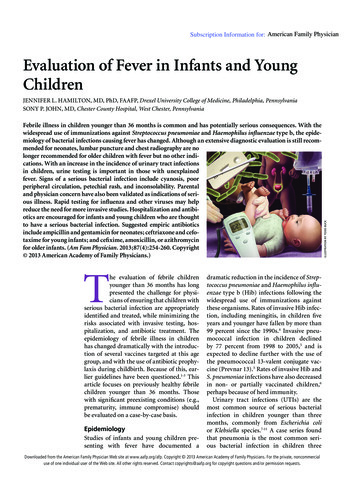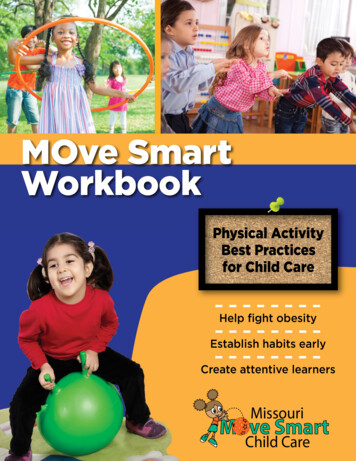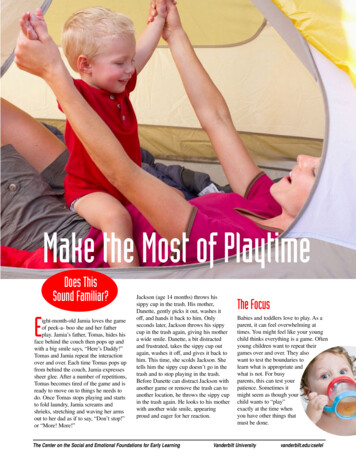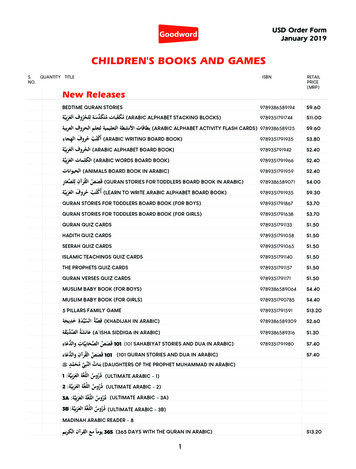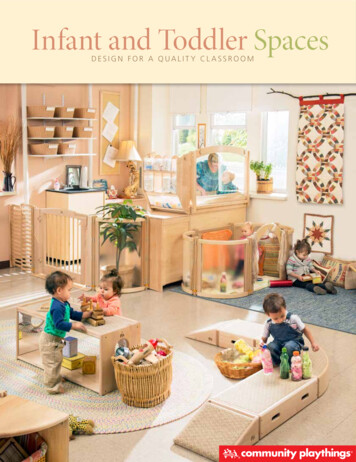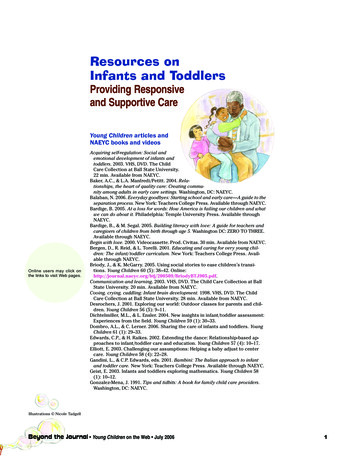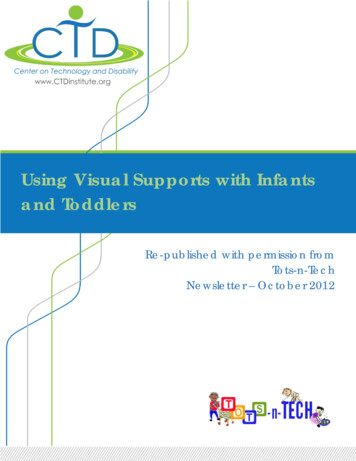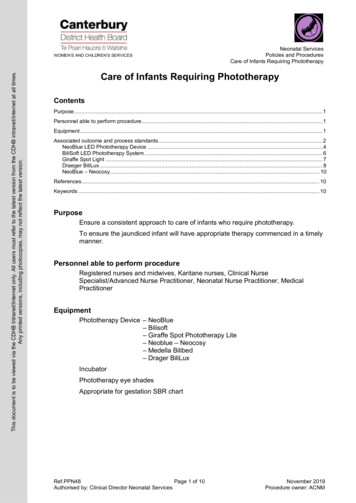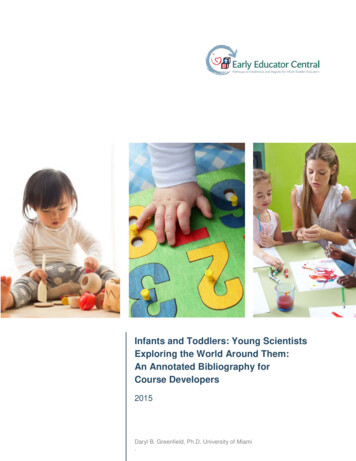
Transcription
Infants and Toddlers: Young ScientistsExploring the World Around Them:An Annotated Bibliography forCourse Developers2015Daryl B. Greenfield, Ph.D. University of Miami.
ContentsIntroduction . 1Quick Reference Table . 3Defining Science Education . 6Why Science Education Belongs in Early Childhood Classrooms. 7Early Science, Executive Functioning and Approaches to Learning . 9Assessment in Early Childhood Science .11Understanding Infant-Toddler Development .11Guided Learning .14Supporting Early Science Learning .16Summary: Why Science for Infants and Toddlers .18About the Author .19Note: This paper was created through Early Educator Central, a web portal federally administered by theU.S. Department of Health and Human Services, Office of Child Care and Office of Head Start, inresponse to the need for relevant resources to enhance infant-toddler content and coursework. ICFserved as the contractor under Contract #HHSP23320095636WC HHSP2337034T with the Departmentof Health and Human Services. The views expressed in the document are those of the author and ICF.No official endorsement by the U.S. Department of Health and Human Services is intended or should beinferred.I N F AN T S AN D T O D D L E R S : Y O U N G S C I E N T I S T S E X P L O R I N G T H E W O R L D A R O U N D T H E Mi
IntroductionScience teaching and learning in the U.S. K-12 education system is shifting from covering a largenumber of topics in a fragmented, disconnected and shallow way (often characterized as a milewide and an inch deep) to a focus on a small number of core or big ideas in four content areas(NRC, 2012; see annotated review in Defining Science Education section of this paper.) This newapproach also emphasizes the critical needs for students to “practice” science and attend to“cross-cutting” concepts. The framework emphasizes the integration of three dimensions: 1) eightscience practices; 2) seven cross-cutting concepts; and, 3) the core ideas in four content domains,into the teaching and learning of science (e.g., learning science by doing science).Although this new framework begins at kindergarten (K), there is also much interest in scienceeducation for younger children. A major national report that was a precursor to the new K-12framework has an entire chapter devoted to the advantages of beginning science education earlierthan K (Chapter 3: Foundations for science learning in young children, National Research Council,2007; see annotated review in Understanding Infant-Toddler Development section of this paper.)Also, in just a few years, states have transitioned their early learning standards from including onlya few science indicators embedded in a general “cognition and knowledge” domain to includingscience as a free standing elaborated readiness domain1. In addition, the Head Start Early LearningOutcomes Framework: Ages Birth to Five 2, designed as a continuum of learning from infancythrough preschool, designates “scientific reasoning” as one of its central domains. Also this year,an entire edited volume was published on research in early childhood science education. 3This emerging literature on science education in early childhood has largely been focused on thepreschool years (ages 3 to 5 year olds). However, three years of age is not a “magical” time tobegin science education. Indeed, infants have been characterized as “scientists in the crib”4. Justas preschool serves as the foundation for science education in elementary school, attention to thedevelopmentally appropriate aspects of science learning in infancy and toddlerhood will aid thethree year old on her journey as a young scientist.Because of the lack of knowledge on evidence based practices in science for infants and toddlers,this review draws upon more basic theory and research on infant and toddler development,highlighting its relevance to science education for these age groups. This is a more useful andnecessary approach given the lack of a literature supporting evidence-based practices for1Barnett, W.S., Carolan, M.E., Squires, J.H., Clarke Brown, K., & Horowitz, M. (2015). The state of preschool 2014:State preschool yearbook. New Brunswick, NJ: National Institute for Early Education Research.2 Department of Health and Human Services, Administration for Children and Families, Office of Head Start (2015).Head Start early learning outcomes framework: Ages birth to five. Retrieved ch/cdelf/index.html3 Trundle, C. & Saçkes, K. (2015). Research in early childhood science education. New York: Springer Publishing.4 Gopnick, A., Meltzoff, A. & Kuhl, P. (1999) The Scientist in the Crib: Minds, brains and how children learn. NewYork, NY: HarperCollins Publishing Co.I N F AN T S AN D T O D D L E R S : Y O U N G S C I E N T I S T S E X P L O R I N G T H E W O R L D A R O U N D T H E M1
introducing infants and toddlers to science. Such evidence will hopefully accumulate over time, ashas been the case with the emergence of evidence based practices for science for preschoolers5.This review supports the goal of creating greater continuity in young children’s development acrossall of early childhood (typically defined as birth through 8 years of age). To this end, the new K-12conceptual framework for science is reviewed. The framework has relevance for children prior tokindergarten and states have already begun to create preschool early learning standards that aremodeled after the framework 6. The framework also has relevance for development during infancyand toddlerhood.5Trundle, C. & Saçkes, K. (2015). Research in early childhood science education. New York: Springer Publishing.Worth, K. & Winoker, J. (2013, January, February). The development of pre-k science, technology, and engineeringstandards. Presentation at a series of community forums for proposed preschool science, technology, andengineering (STE) standards sponsored by the Massachusetts State Government Office of Education. MA: variouslocations.62 H T T P S : / / E AR L Y E D U C AT O R C E N T R AL . AC F . H H S . G O V
Quick Reference TableTopic AreaAge GroupDocument TypeFull CitationNational Research Council (2012). A framework for K-12Bookscience education: Practices, crosscutting concepts, and coreideas. Washington, DC: The National Academies Press.Empirical Research Greenfield, D.B., Jirout, J., Domínguez, X., Greenberg, A.,Maier, M.F., & Fuccillo, J.M. (2009). Science in the preschoolclassroom: A programmatic research agenda to improvescience readiness. Early Education and Development, 20, 238264.Webinar/ Empirical Greenfield, D.B. (2013, January). Science in the preschoolclassroom: Why and how this can be a teacher’s best friend.ResearchFront Porch Series, National Center for Quality Teaching andLearning, University of Washington, Seattle, WA. Availablefrom ng/practice/fp/fpArchive2013.htmlGreenfield, D.B. (in press). The power of inquiry: Why scienceBook Chapterbelongs in early childhood classrooms. In E. Näslund-Hadleyand R Bando (Eds.), The death of rote memorization: Earlygrade math and science learning in Latin America and theCaribbean. Washington, DC: Inter-American DevelopmentBank.Empirical Research Bustamante, A.S., White, L.J. & Greenfield, D.B. (2015).Approaches to learning and school readiness in Head Start:Applications to preschool science. Manuscript submitted forpublication.Defining ScienceEducationK-12Why Science inEarly ChildhoodEarly ChildhoodWhy Science inEarly ChildhoodEarly ChildhoodWhy Science inEarly ChildhoodEarly ChildhoodEarly Science,ExecutiveFunctioning andApproaches toLearningEarly ChildhoodEarly Science,ExecutiveFunctioning andApproaches toLearningEarly ChildhoodEmpirical Research Nayfeld, I., Fuccillo, J.M. & Greenfield, D.B. (2013). Executivefunctions in early learning: Extending the relationship betweenexecutive functions and school readiness to science. Learning &Individual Differences, 26, 81 – 88.AssessmentEarly ChildhoodBook ChapterGreenfield, D.B. (2015). Assessment in early childhood scienceeducation. In K. Trundle, & M. Saçkes (Eds.), Research in earlyI N F AN T S AN D T O D D L E R S : Y O U N G S C I E N T I S T S E X P L O R I N G T H E W O R L D A R O U N D T H E M3
4 Topic AreaAge GroupDocument TypeFull Citationchildhood science education (pp. 353 – 380). N.Y.: SpringerPublishing Co.Chouinard, M. M. (2007). Children’s questions: A mechanismfor cognitive development [Monograph]. Society for Research inChild Development, 27(1), vii–ix, y opmentEarly tEarly tEarly tEarly tEarly ChildhoodGuided LearningEarly ChildhoodGuided LearningEarly ChildhoodGuided LearningEarly ChildhoodVygotsky, L. S. (1978). Mind in society: The development ofhigher mental processes (M. Cole, V. John-Steiner, S. Scribner,& E. Souberman, Trans.). Cambridge, MA: Harvard UniversityPress.Empirical Research Alfieri, L., Brooks, P. J., Aldrich, N. J., & Tenenbaum, H. R.(2010). Does discovery-based instruction enhance learning?Journal of Educational Psychology, 103, 1–18.Empirical Research Weisberg, D.S., Hirsh-Pasek, K., & Golinkoff, R.M. (2013).Guided play: Where curricular goals meet a playful pedagogy.Mind, Brain & Education. 7 (2), 104 – 112.Empirical Research Ferrara, K., Hirsch-Pasek, K., Newcome, N.S., Golinkoff, R.M.,& Lam, W.S. (2011). Block talk: spatial language during blockplay. Mind, Brain & Education, 5 (3), 143- 151.Committee on the Science of Children Birth to Age 8. (2015).Transforming the workforce for children birth through age 8: Aunifying foundation. L. Allen, & B. Kelly (Eds.). Washington,D.C.: The National Academies Press.National Research Council (2007). Taking science to school:Learning and teaching science in grades K-8. Committee onscience learning: Kindergarten through eighth grade. R. A.Duschl, H.A. Schweingruber & A.W. Shouse (Eds.).Washington, DC: The National Academic Press.Piaget, J. (1969). The psychology of intelligence. N Y: Littlefield,Adams.Piaget, J., & Inhelder, B. (1969). The psychology of the child.NY: Basic Book, Inc.BookH T T P S : / / E AR L Y E D U C AT O R C E N T R AL . AC F . H H S . G O V
Topic AreaAge GroupDocument TypeSupporting EarlyScience LearningInfants & ToddlersPractical Tips/ResearchSupporting EarlyScience LearningInfants & ToddlersPractical TipsSupporting EarlyScience LearningInfants & ToddlersPractical TipsSupporting EarlyScience LearningEarly ChildhoodBookFull CitationEarly Head Start National Resource Center. (2013). Supportingoutdoor play & exploration for infants & toddlers (TechnicalAssistance Paper #14). Retrieved hsnrc/docs/ehs-tapaper-14-outdoor-play.pdfU.S. Department of Health and Human Services, Administrationfor Children and Families, Office of Head Start. (2008, July).Infant/Toddler math & science development: Does Early HeadStart support math and science development with infants andtoddlers? (Tip Sheet # 29). Retrieved snrc/cde/curriculum/DoesEarlyHeadS.htmU.S. Department of Health and Human Services, Administrationfor Children and Families, Office of Head Start (2014, May).News you can use: Early science learning for infants & toddlers,News for Head Start, Early Head Start & Migrant/SeasonalPrograms Retrieved from /cde/curriculum/early-science.htmlShillady, A. (Ed.). (2013). Spotlight on young children: Exploringscience, Washington, D.C.: National Association for theEducation of Young Children.I N F AN T S AN D T O D D L E R S : Y O U N G S C I E N T I S T S E X P L O R I N G T H E W O R L D A R O U N D T H E M5
Defining Science EducationNational Research Council (2012). A framework for K-12 science education: Practices,crosscutting concepts, and core ideas. Washington, DC: The National Academies Press.This volume resulted from the work of a National Research Council taskforce that reviewed thecurrent approach to K-12 science education in the context of concerns about the need for thetraining of science and engineering professionals for the U.S. to stay competitive in the internationalarena with an eye towards increasing the number of women and members of minority groups inthese fields. Although not all K-12 students would be expected to choose such career paths, anadditional concern was that the education system needs to create scientifically literate citizens whocan make informed public and personal decisions, as science, engineering and technology playever increasing roles in all phases of American life.The report documents the prior approach to science education in the U.S. and why thisfragmented, “mile wide, inch deep” approach, disconnected from students’ everyday lives has ledto largely science illiterate citizens who do not view science and engineering as interesting orimportant career paths.The new framework consists of three dimensions that are to be integrated for teaching andlearning science. The new framework focuses on students learning a small set of core “big” ideasin depth across the entire K-12 system in the context of doing science. Eight science practices(e.g., asking questions, planning and carrying out investigations) comprise the first dimension of theframework. The second dimension consists of seven cross-cutting concepts that are relevant in allareas of science (e.g., patterns, cause and effect). The third dimension is a small set (2 to 4) ofcore or big ideas, in each of four disciplinary areas (life science, physical science, earth and spacescience, and engineering).The science practices, cross-cutting concepts and core ideas in the K-12 framework all have highrelevance for infant and toddler development. The general theories of development briefly reviewedare highly consistent with the framework and understanding the framework will aid in making thesetheories come alive when they are applied to practice.Applying the K-12 framework to infants and toddlers, however, is challenging as the framework isnot written in “early childhood friendly” language. The author of this paper and his team areworking on a document that provides a more “early childhood friendly” version of the framework aspart of an Early Science Initiative (ESI) grant funded by the Buffet Early Childhood Fund. The “earlychildhood friendly” version of the framework should be available in early 2016 on a websitedeveloped for the ESI project. Some preliminary work on this document is highlighted below:Dimension 1- Science practices/developing and using models:6 H T T P S : / / E AR L Y E D U C AT O R C E N T R AL . AC F . H H S . G O V
In K-12 framework – “construction and use of a wide variety of models and simulationsto help develop explanations about natural phenomena”Preschool friendly example – drawing a house and building it in the block center.Infant-Toddler friendly example – stacking blocks to make a simple structureDimension 2-Cross-cutting concepts/systems and system models: In K-12 framework – “defining the system under study – specifying its boundaries andmaking explicit a model of that system”Preschool friendly example – the gears and parts of a wind-up toy exist within a systemand interact to make it function.Infant-Toddler friendly example – the parts of my body and how I can use them tointeract with the world in specific ways (i.e. I use my hands to pick things up)Dimension 3- Disciplinary core ideas/motion and stability and forces and interactions: In K-12 framework – “how one can explain and predict interactions between objectsand within systems of objects”Preschool friendly example - kicking a ball makes it roll.Infant-Toddler friendly example – shaking a rattle makes a soundWhy Science Education Belongs in Early ChildhoodClassroomsDespite many states now including science as a separate and free-standing school readiness areaand the Office of Head Start designating “scientific reasoning” as one of its central domains,science remains largely absent from early childhood classrooms. This is unfortunate, as scienceprovides many advantages for high quality teaching and learning. The references cited in thissection are briefly reviewed to provide insight into this issue. Much of the discussion is focused onthe importance of increasing science education during the preschool years; however, these issuesand concerns are just as relevant for the birth to three age range, as educators of young childrenshould not wait until children turn three years of age to take advantage of infants’ and toddlers’strong interest in exploration and inquiry about the world in which they live.Greenfield, D.B., Jirout, J., Domínguez, X., Greenberg, A., Maier, M.F., & Fuccillo, J.M.(2009). Science in the preschool classroom: A programmatic research agenda to improvescience readiness. Early Education and Development, 20, 238-264.This journal article contains 3 empirical studies.The first study analyzed data on eight school readiness domains in a large cohort of four year oldsattending Head Start programs across the state of Florida, using a formative assessment system(Galileo, eschool.html) implemented byteachers. IRT provides interval level of measurement so that these eight domains can be compareddirectly in terms of initial ability level at the beginning of the school year and the amount of gainI N F AN T S AN D T O D D L E R S : Y O U N G S C I E N T I S T S E X P L O R I N G T H E W O R L D A R O U N D T H E M7
across the school year (height and weight are other examples of interval level of measurementsystems; a key property of interval level of measurement is that the unit of change is identicalacross the entire range of values, e.g., an increase of five pounds is an identical gain in weight,regardless if the person weighs 100 pounds or 180 pounds). Science had the lowest fall scoresand the least amount of gain across the school year. These results, anticipated to be similar inother states, indicate that on average, children attending Head Start programs are least preparedfor science when entering kindergarten compared to their readiness in seven other domains.The second study addresses the issue of why science is largely absent from early childhoodclassrooms. Based on qualitative analysis of focus groups with Head Start teachers these keyfactors emerged: 1) teachers feel poorly prepared to teach science and have misconceptionsabout how to teach science that reinforce these concerns and fears; 2) there are many readinessareas to cover; 3) given young children’s short attention spans, fewer opportunities for instructionand the tendency to cover each readiness area one at a time in isolation, not all readiness areascan be adequately addressed. Since teachers are uncomfortable teaching science and viewscience as less importance because it is not typically assessed (see more about this below), it isthe first readiness area to be left out of instruction, and as a consequence is largely absent fromearly childhood classrooms.The third study uses a quasi-experimental design to test the impact of engaging a select group ofHead Start teachers in a science unit that involved them in the hands-on learning that they thenimplemented in their classrooms over an extended period of time. Teachers met monthly as aprofessional learning community reflecting on their initial misconceptions, children’s natural interestin the science learning and the ease of including other readiness areas in the science unit. Analysisof data from Galileo (see link to this system in Study 1) resulted in higher readiness scored forchildren in these teachers’ classrooms in all readiness areas compared to a control group ofteachers who were not part of this project.In summary, this empirically based set of studies documents the reasons for a lack of focus onscience education in early childhood classrooms that results in low science readiness atkindergarten entry. These studies also point to the potential benefits of engaging early childhoodteaching staff in meaningful, goal-directed science inquiry with their young children to increasesmultiple areas of their school readiness including science.Greenfield, D.B. (2013, January). Science in the preschool classroom: Why and how thiscan be a teacher’s best friend. Front Porch Series, National Center for Quality Teachingand Learning, U of Washington, Seattle, WA. Available eaching/practice/fp/fpArchive2013.htmlThis thirty minute webinar presentation is part of the Office of Head Start’s National Center forQuality Teaching and Learning Front Porch Monthly series. The presentation is aimed at earlychildhood teaching staff. The website description for this webinar is: “Science is a Head Start8 H T T P S : / / E AR L Y E D U C AT O R C E N T R AL . AC F . H H S . G O V
mandated readiness domain. So why is science rarely present in Head Start classrooms? Whensurveyed, teachers report two key barriers: Feeling unprepared to teach science and a lack of timeto devote to it, given all the readiness areas that need to be covered. Dr. Greenfield discussed whythese barriers are false and how science can help teachers increase scores on the CLASS "instructional support" domain, and cover and improve multiple areas of school readiness forchildren.” The link above provides access to this archived presentation from January, 2013 to 1)watch the webinar from the website; 2) download the webinar to watch later (mp4 file); 3)download the transcript of the webinar (pdf file); and 4) download the question and answer sessionfollowing the live presentation (pdf file).Greenfield, D.B. (in press). The power of inquiry: Why science belongs in early childhoodclassrooms. In E. Näslund-Hadley and R. Bando (Eds.), The death of rote memorization:Early grade math and science learning in Latin America and the Caribbean. Washington,DC: Inter-American Development Bank.This chapter reviews theory, research and practice on early childhood science education. It iswritten for policy makers and early childhood educators in Latin America and the Caribbean, but isbased on work conducted in the U.S., and has clear relevance for early childhood scienceeducation in the U.S. Chapter topics include why science is missing in early childhood classrooms,the benefits of fostering scientific learning in the early childhood classrooms, how children learnscience, the benefits of science for high quality teaching, how science can support advances inother “readiness areas,” early childhood teachers’ misperceptions about teaching science, definingand assessing early science skills. The volume will be published in both English and Spanish,anticipated no later than early 2016. All chapters have undergone a rigorous review process andcurrently going through a final level of review prior to publication.Early Science, Executive Functioning and Approaches toLearningTeachable competencies that impact multiple domains of learning are beginning to receiveincreased attention in early childhood education. These include executive functioning withcomponents such as flexibility, inhibition and working memory and approaches to learning withcomponents such as curiosity, initiative, persistence, planning, and engagement in group learning.Being flexible and persistence, for example, aids a young child, regardless of what she is trying tolearn.The development of these competencies is well suited for goal directed learning. This can occur inany readiness area (e.g., learning to crawl or walk, learning the letters and sounds of the alphabet,learning to count). The references reviewed below extend the relationship of these competenciesto early science and suggest that scientific inquiry and learning provide optimal experiences inwhich competencies such as persistence and planning may be practiced and refined because theytake advantage of children’s natural interest in the world around them and how it works.I N F AN T S AN D T O D D L E R S : Y O U N G S C I E N T I S T S E X P L O R I N G T H E W O R L D A R O U N D T H E M9
Bustamante, A.S., White, L.J. & Greenfield, D.B. (2015). Approaches to learning andschool readiness in Head Start: Applications to preschool science. Manuscript submittedfor publication.The purpose of this empirical study was to determine if the relationship between executive function(EF) and science found in the Nayfeld, Fuccillo and Greenfield study (2013) was present in anotherkey early childhood competencies that affect multiple areas of school readiness area, approachesto learning (ATL). A large sample (N 397) of children attending Head Start were directly assessedon their vocabulary, listening comprehension, mathematics, and science ability at the beginningand end of the school year. Teachers completed an ATL rating scale during the winter. End ofyear achievement scores, controlling for beginning of year achievement scores were analyzed in astructural equation modeling framework to assess the role of ATL in predicting increases inlanguage, listening comprehension, mathematics and science. Only gains in science weresignificantly related to ATL.In summary these two studies suggest that EF and ATL competencies, critical to early learning,may best be developed and utilized in the context of early science learning. EF and ATLcompetencies such as planning, group learning, initiative and flexibility are more likely to be utilizedand developed when children are engaged in learning that require brainstorming, reasoning, andhigher level thinking than when the learning is rote. Science learning in young children that involvesexploration and inquiry not only has all these features, it is also generated by children’s motivated,goal directed curiosity to understand their world. This motivated, goal directed curiosity is presentin young infants and toddlers making early science education an important opportunity to begindeveloping these important competencies.Nayfeld, I., Fuccillo, J.M. & Greenfield, D.B. (2013). Executive functions in early learning:Extending the relationship between executive functions and school readiness to science.Learning & Individual Differences, 26, 81 – 88.Prior research has shown that executive functions predict achievement in both language andmathematics during early childhood. The present empirical study replicates these findings andextends them to science. A large sample (N 278) of children attending Head Start were directlyassessed on their vocabulary, listening comprehension, mathematics, science and executivefunction ability at the beginning of the school year. Vocabulary, listening comprehensionmathematics and science ability was assessed again at the end of the school year. End of yearachievement scores, controlling for beginning of year achievement scores were analyzed in astructural equation modeling framework to assess the role of executive function (EF) in predictingincreases in language, listening comprehension, mathematics and science. EF significantlypredicted the gains in all four areas. However, the relationship between EF and science wasstronger than the relationship between EF and vocabulary, listening comprehension andmathematics. In other words, higher EF was related to greater gains in science than gains in theother three areas that were assessed.10 H T T P S : / / E AR L Y E D U C AT O R C E N T R AL . AC F . H H S . G O V
Assessment in Early Childhood ScienceGreenfield, D.B. Assessment in Early Childhood Science Education. (2015). In K. Trundle,& M. Saçkes (Eds.), Research in early childhood science education (pp.353 – 380).N.Y.:Springer Publishing Co.Empirical research that validates the effectiveness of early childhood programs and practices is anessential component of establishing a strong evidence base for what constitutes best practices.Practices and programs in early science are not exceptions. To conduct such research,assessments that are reliable and valid are needed to answer the questions being addressed forthe specific population that is being assessed.This chapter reviews the current state of assessment in early science education. There isunfortunately, little of this assessment work that has been completed or published, but promisingwork is underway and also reviewed. In addition, the chapter provides a comprehensive approachto assessment that is consistent with the new K-12 framework for science education in the hope ofproviding consistency in the assessment work that lies ahead. In addition to a section on thisframework there are sections on: 1) summative assessments of young children’s sciencecompetence; 2) screening
three year old on her journey as a young scientist. Because of the lack of knowledge on evidence based practices in science for infants and toddlers, this review draws upon more basic theory and research on infant and toddler development, highlighting its relevance to science

